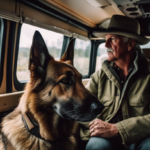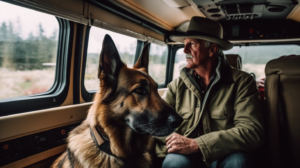
Traveling with dogs in RV
Traveling with Pets: The Ultimate Guide for RV and Van Life
Hello fellow travelers! If you, like me, can’t imagine hitting the open road without your furry (or feathery, or scaly) friends by your side, you’re in the right place. As a seasoned van-lifer with two dogs and a cat, I’ve learned a thing or two about making RV and van life work with pets. Let’s dive in, shall we?
Understanding Your Pet’s Needs
Before you even start the engine, you need to consider your pet’s unique needs and behaviors. Some pets take to travel like ducks to water, while others might need some convincing. Try taking your pets on short trips first to acclimate them to the moving vehicle. You can gradually increase the distance over time. If your pet has particular needs or behavioral quirks, make sure you think about how you’ll manage them on the road.
Creating a Pet-Friendly Environment in Your RV/Van
Ensuring your vehicle is comfortable and safe for your pet is paramount. This means creating a secure space for them during travel and at rest. Pet-proofing your RV or van can involve securing cabinets, covering sharp edges, and ensuring that there are no escape routes for curious pets. Investing in a quality pet bed or carrier can give your pet a designated, safe space to call their own.
Managing Pet Food and Hydration on the Road
Just as you need fuel for your travels, so do your pets. Storing pet food efficiently and safely in your RV or van can be tricky, especially for long trips. I recommend using airtight storage containers to keep food fresh and prevent spills. As for hydration, always ensure your pet has access to fresh water. It’s also important to note that pets can get dehydrated during long trips, so regular water breaks are essential.
Exercise and Entertainment for Pets
When it comes to RV and van life, regular exercise and mental stimulation are key for pets. Make sure to take regular stops at pet-friendly spots where your furry friends can stretch their legs and play. For our feline friends who prefer the great indoors, investing in interactive toys can keep them stimulated even on long travel days.
Healthcare for Pets on the Road
Keeping up with your pet’s healthcare while traveling is a must. Before you hit the road, ensure all vaccinations are up to date and have a plan in place for any medication your pet may need. Knowing where vet services are along your route can also be a lifesaver in case of emergencies.
Rules and Regulations: Pets in Campgrounds and Public Spaces
Rules can vary greatly from one campground or public space to another. Always check ahead to understand their pet policies. Remember, a key part of RV and van life with pets is respect for others. Keeping pets leashed where required, picking up after them, and ensuring they’re not disturbing others are all important.
Traveling with Different Types of Pets
While I travel with a dog, I know some of you have birds, reptiles, or other types of pets. Each animal has different needs and considerations. For example, traveling with a dog might mean regular stops for walks, while birds might need a secure and comfortable cage and a quiet environment.
Pet Training for Travel
Before setting out on your RV or van life journey with your pet, it’s crucial to invest some time in travel-specific training. This will not only ensure your pet’s safety but will also enhance the enjoyment of your trip.
- Leash and Recall Training: If you’re travelling with a dog, ensure they’re well-trained on a leash and have good recall abilities. You never know when these skills will come in handy in a new environment.
- Familiarization with Vehicle: Gradually introduce your pet to your RV or van. Start with short periods in the parked vehicle, then do short drives, and gradually increase the distance.
- Crate Training: Crate training can provide a safe and comfortable space for your pet during travel times. Ensure the crate is secured and that your pet is comfortable and accepts the crate as a positive place.
- Commands and Cues: Teach your pet commands such as ‘leave it’, ‘stay’, and ‘quiet’. These can be particularly useful when encountering wildlife or other distractions on your travels.
Dealing with Pet Anxiety and Motion Sickness
Travel can be stressful for pets. Some might experience anxiety or motion sickness during the initial phases of your journey. But with some careful strategies, you can help them adjust and enjoy the journey.
- Consult a Vet: If your pet is prone to travel anxiety or motion sickness, consult your vet before setting off. They might recommend medications or other treatments to help ease your pet’s discomfort.
- Create a Comforting Environment: Bring your pet’s favorite toys, blankets, or bed to create a familiar and comforting environment inside the RV or van.
- Frequent Breaks: Make sure to take frequent breaks during long drives to allow your pet to stretch, relieve themselves, and take a break from the motion of the vehicle.
- Positive Reinforcement: Use positive reinforcement to help your pet associate travel with positive experiences. Treats, praise, and affection can go a long way in alleviating their anxiety.
Traveling with pets in an RV or van can be a wonderful experience, filled with memorable moments and bonding opportunities. It just requires a bit of planning and preparation to ensure that everyone enjoys the journey.
Conclusion
Traveling with pets in your RV or van can be one of the most rewarding experiences. Yes, it does come with challenges, but with the right preparation, you’ll find the journey just as fulfilling for your pets as it is for you. From understanding their unique needs, to creating a pet-friendly environment, and ensuring their health needs are met, each step will bring you closer to an unforgettable adventure with your furry friends.
Call to Action
Now it’s your turn! I’d love to hear your stories, tips, and questions about traveling with pets in the comments below. And if you’ve found this guide helpful, don’t forget to subscribe for more pet-friendly travel content. The journey is always better when we share it together!
Frequently Asked Questions
Finally, let’s address some common queries about managing pet travel in RV and van life.
- Can all pets adapt to life on the road? Most pets can adapt to life on the road with time and proper preparation. However, each pet is unique, so it’s important to take things at your pet’s pace and monitor their behavior closely.
- How do I handle my pet’s waste when boondocking? Portable pet waste disposal systems are available, which are eco-friendly and easy to use. Always adhere to leave-no-trace principles and dispose of pet waste responsibly.
- What if my pet gets sick on the road? Have a plan in place before you hit the road. Know the location of vets and emergency animal hospitals along your route. Also, telemedicine for pets is increasingly popular and can be a great resource while traveling.
Remember, RV and van life with pets can be a bit of a wild ride, but with patience, preparation, and a whole lot of love, the rewards are immeasurable. Here’s to happy trails and wagging tails (or content purrs, or chirpy tweets) on your next adventure!
Remember, the open road is waiting, and there’s room for everyone – even our furry friends. Happy travels!
Embracing the Open Road: A Comprehensive Guide to RV Living with Pets
Welcome, fellow travelers and pet lovers! As an RV enthusiast and pet owner, I understand the excitement and challenges of hitting the open road with our furry friends. They’re our companions, our family, and the thought of leaving them behind can be heart-wrenching. So why not bring them along on our adventures?
Why Travel with Your Pet in an RV?
There are numerous benefits of RV travel with pets. On the emotional front, pets provide companionship, comfort, and joy, which can significantly enhance your traveling experience. The shared adventures also strengthen the bond between you and your pet.
For pets, the health benefits can be substantial. The physical activity from exploring new surroundings, coupled with quality time spent with you, can contribute to their overall wellbeing. Pets, like us, thrive on new experiences!
Choosing the Right RV for Your Pet
Just like how every pet is unique, every RV is different. When choosing a pet-friendly RV, the size, layout, and safety features are important factors to consider. Large dogs might need more space, whereas cats might appreciate more vertical space for climbing and perching.
Making your RV comfortable for pets involves small modifications, like adding pet beds in cozy corners or installing a cat tree. Remember, your RV is their home too, so consider their comfort and safety when designing the layout.
Pet-Proofing Your RV
Pet-proofing is crucial when it comes to RV living with pets. This involves securing cabinets, covering sharp edges, and ensuring your pet can’t accidentally escape. It’s also important to think about safe storage of pet food and toys. Be creative with storage solutions to avoid clutter while keeping your pet’s necessities accessible.
Essential Pet Travel Accessories
When you’re traveling with pets in an RV, certain accessories become indispensable. Collapsible bowls, pet seat belts, and portable litter boxes are just a few essentials. A pet first aid kit is also a must. Do your research and choose quality pet travel accessories that offer durability and comfort.
Pet Health and Safety During RV Travels
Taking care of your pet’s health while on the road is paramount. Regular vet check-ups and keeping up-to-date with vaccinations are important. You should also be prepared for handling pet illnesses during travel. Pack their medications and have a plan for finding veterinary services in different areas.
In terms of emergency preparedness, make sure you have your pet’s medical records handy and keep an emergency contact list that includes the nearest 24-hour animal hospitals on your route.
Managing Pet Behavior and Stress During Travel
Training your pet for travel and dealing with travel-related pet anxiety are crucial aspects of the journey. Take small trips to get your pets accustomed to the RV. Also, consider investing in comfort objects, like their favorite blanket or toy, to make them feel safe and secure.
Finding Pet-Friendly Campgrounds and Stops
Doing a little homework can go a long way in finding pet-friendly campgrounds and stops. There are several resources online that can help you with this. Also, be mindful of the rules and etiquette for pets at campgrounds and RV parks to ensure a pleasant experience for everyone.
Maintaining Your Pet’s Routine During Travel
Maintaining feeding and exercise routines is essential for pet health and happiness. Adapt their routines to the RV lifestyle and different travel situations. If your dog needs a daily run, plan for stops that allow them to stretch their legs. For cats, consider interactive toys that can keep them entertained.
Real-life Experiences: Stories from Pet-owning RV Travelers
Lastly, hearing from fellow RV travelers who also have pets can be immensely helpful. In future posts, we’ll share experiences, challenges, and tips from this community, providing you with a wealth of real-world advice.
Conclusion
So there you have it, a comprehensive guide to embracing RV life with your pets. It may require a bit of planning and preparation, but the joy and companionship of having your pet by your side during your adventures are incomparable.
Feel free to share your experiences, ask questions, or share any tips you might have about RV living with pets. We’re all in this journey together!
Frequently Asked Questions
Q: What are some pet-friendly RV modifications? A: This can range from adding pet doors to installing secure pet crates, adding extra ventilation, and more.
Q: How can I keep my pet entertained during long drives? A: Bring along chew toys, interactive toys, and consider puzzle feeders to keep them engaged. Regular breaks can also help by providing a change of scenery and exercise.
Q: How do I deal with my pet’s anxiety during travel? A: Gradual acclimatization to the RV, comfort objects, and even calming pet music can help. If your pet’s anxiety is severe, consider consulting with a vet for professional advice.



